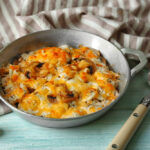Introduction to Cabbage and Noodles with Kielbasa (Haluski)
You’re probably familiar with the comforting flavors of cabbage and noodles, but did you know this simple combination has a rich history in Polish cuisine? It’s called Haluski, a dish that’s been a staple on Polish tables for generations.
The beauty of Haluski lies in its simplicity and versatility. It’s a dish that can be whipped up quickly with pantry staples, making it a perfect weeknight dinner. Plus, it’s easily adaptable to different dietary needs and preferences, from hearty meat-filled versions to lighter vegetarian options.
Understanding the Ingredients and Their Importance
The Star Ingredient: Kielbasa
Kielbasa is the heart and soul of this dish, adding a smoky, savory depth of flavor that truly elevates the experience. If you’re looking to make Haluski at home, you’ll find a wide range of kielbasa styles and flavors available at Polka Deli. From traditional Polish kielbasa with its signature smoky taste to specialty sausages like krakowska, Black Forest, and hunter style, you’re sure to find the perfect kielbasa for your recipe. Don’t forget to check out our selection of kielbasa and sausage – it’s truly something to savor!
Cabbage: The Hearty Base
The cabbage in Haluski adds a satisfying crunch and a subtle sweetness that complements the richness of the kielbasa. It’s usually sliced thinly, sautéed until softened, and then tossed with the noodles.
Egg Noodles: The Perfect Accompaniment
Egg noodles are the classic choice for Haluski, providing a fluffy, comforting texture that perfectly absorbs the flavors of the kielbasa and cabbage. You can use store-bought noodles or even try your hand at making your own. Remember, wide egg noodles are best for this dish, as they hold up well to the other ingredients and create a satisfying bite.
Exploring Regional Variations and Culinary Influences
Haluski in Polish Cuisine
While the basic recipe for Haluski remains consistent throughout Poland, different regions have their own unique variations. Some might use different types of kielbasa, while others might incorporate additional ingredients like onions, garlic, or even a touch of red wine vinegar for added complexity.
American Influences: The Pittsburgh Connection
Haluski has a strong presence in American cuisine, especially in Pittsburgh, Pennsylvania. In this region, the dish is often considered a traditional comfort food, and it’s commonly found on restaurant menus and at family gatherings.
Beyond Polish Borders: Other Eastern European Influences
The origins of Haluski are a bit of a mystery, with some tracing it back to other Eastern European countries like Slovakia, Ukraine, or even Russia. These influences often lead to different noodle variations, like potato dumplings or a more elaborate filling for the dish.
A Step-by-Step Guide to Preparing Cabbage and Noodles with Kielbasa
Recipe for Cabbage and Noodles with Kielbasa
Here’s a simple recipe for Haluski that you can easily prepare at home:
Ingredients:
- 12 ounces kielbasa, sliced
- 1 head of green cabbage, thinly sliced
- 1/2 cup butter
- 1/2 teaspoon salt
- 1/4 teaspoon black pepper
- 1 pound wide egg noodles, cooked according to package instructions
Instructions:
- In a large skillet or Dutch oven, melt butter over medium heat.
- Add sliced kielbasa and cook until lightly browned on all sides.
- Add sliced cabbage and cook until softened, about 5-7 minutes.
- Season with salt and pepper to taste.
- Add cooked egg noodles to the skillet and toss to combine.
- Serve immediately and enjoy!
Pro Tips for Flavor Enhancement
To elevate your Haluski, try these tips:
- Browning the kielbasa before adding the cabbage adds a beautiful depth of flavor.
- A splash of red wine vinegar adds a touch of acidity and complexity to the dish.
- Don’t be afraid to experiment with different types of kielbasa or even try using smoked sausage for a smoky kick.
Serving Suggestions and Variations
Haluski is a versatile dish that can be enjoyed in many ways. It’s delicious on its own or can be served with a side of rye bread or a simple green salad. For a touch of extra creaminess, try topping your Haluski with a dollop of sour cream or cottage cheese.
To make a meatless version of Haluski, simply omit the kielbasa and add a handful of frozen peas or diced carrots for extra flavor and nutrition. You can also use vegetable broth instead of water to cook the noodles, adding another layer of savory complexity.
The Nutritional Value and Benefits of Cabbage and Noodles with Kielbasa
Cabbage and Noodles with Kielbasa is a hearty and nutritious meal that provides a good source of vitamins, minerals, and fiber. The cabbage is packed with vitamin C and antioxidants, while the noodles provide carbohydrates for energy. The kielbasa adds protein and flavor, making it a well-balanced dish.
This dish is also a great option for busy weeknights, as it can be easily prepared in under 30 minutes.
To make Haluski even more adaptable, you can explore different variations to cater to various dietary needs. The meatless options mentioned earlier are perfect for vegetarians, while those with gluten sensitivities can use gluten-free noodles.
Conclusion: Celebrating the Legacy and Flavor of Cabbage and Noodles with Kielbasa
Haluski is more than just a recipe; it’s a testament to the rich history and culture of Polish cuisine. It’s a dish that brings families together, evokes memories of home-cooked meals, and provides a comforting sense of familiarity.
If you’re looking to explore the flavors of Polish food, Haluski is a great place to start. And with its simple ingredients and versatile nature, it’s a dish that everyone can enjoy.
At Polka Deli, we’re proud to offer a wide selection of authentic Polish ingredients and products, making it easy for you to recreate this classic dish at home. Stop by our store today and let us help you discover the joy of Polish food.





